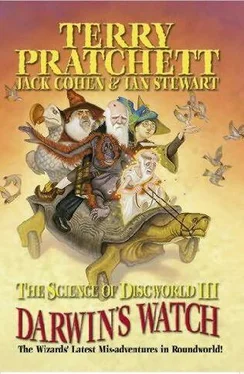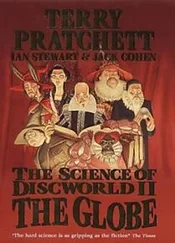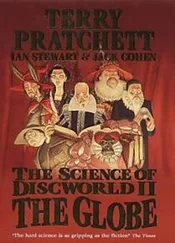Terry Pratchett - The Science of Discworld III - Darwin's Watch
Здесь есть возможность читать онлайн «Terry Pratchett - The Science of Discworld III - Darwin's Watch» весь текст электронной книги совершенно бесплатно (целиком полную версию без сокращений). В некоторых случаях можно слушать аудио, скачать через торрент в формате fb2 и присутствует краткое содержание. Жанр: Фантастика и фэнтези, на английском языке. Описание произведения, (предисловие) а так же отзывы посетителей доступны на портале библиотеки ЛибКат.
- Название:The Science of Discworld III - Darwin's Watch
- Автор:
- Жанр:
- Год:неизвестен
- ISBN:нет данных
- Рейтинг книги:3 / 5. Голосов: 1
-
Избранное:Добавить в избранное
- Отзывы:
-
Ваша оценка:
- 60
- 1
- 2
- 3
- 4
- 5
The Science of Discworld III - Darwin's Watch: краткое содержание, описание и аннотация
Предлагаем к чтению аннотацию, описание, краткое содержание или предисловие (зависит от того, что написал сам автор книги «The Science of Discworld III - Darwin's Watch»). Если вы не нашли необходимую информацию о книге — напишите в комментариях, мы постараемся отыскать её.
The Science of Discworld III - Darwin's Watch — читать онлайн бесплатно полную книгу (весь текст) целиком
Ниже представлен текст книги, разбитый по страницам. Система сохранения места последней прочитанной страницы, позволяет с удобством читать онлайн бесплатно книгу «The Science of Discworld III - Darwin's Watch», без необходимости каждый раз заново искать на чём Вы остановились. Поставьте закладку, и сможете в любой момент перейти на страницу, на которой закончили чтение.
Интервал:
Закладка:
The mammals cleverly avoided all of this faffing around, by making their females thermostatically controlled -'warm-blooded'. What counts is not the warmth of the blood, but the system that maintains it at a constant temperature. The beautifully controlled uterus keeps all kinds of other variables away from the embryos, too, from poisons to predators. It probably `costs' much less in DNA programming to adopt this strategy, too.
This trick, evolved by the mammals, carries an important message. To ask how much information passes across the generations in the DNA blueprint, as textbooks and sophisticated research manuals often do, is to miss the point. How the genes and proteins are used is far more important, and far more interesting, than how many genes or proteins there are in a given creature. Lungfishes and some salamanders, even some amoebas, have more than fifty times as much DNA as we mammals do. What does this say about how complex these creatures are, compared to us?
Absolutely nothing.
Tricks like HSP90, and strategies like warm-bloodedness and keeping development inside the mother, mean that bean-counting of DNA `information' is beside the point. What counts is what the DNA means, not how big it is. And meaning depends on context, as well as content: you can't regulate the temperature of a uterus unless your context (that is, mother) provides one.
The simple-minded `mutation' viewpoint, allied to trendy interpretations of DNA function in terms of `information theory', is often allied with ignorance of biology in other areas. One example is radiation biology and simple ecology as seen by `conservation activists'. Some of these volunteers found five-legged frogs and other 'monsters' downwind of the Chernobyl site, years after the nuclear accident but while radiation levels were still noticeably high. They claimed that the monsters were mutants, caused by the radiation. Other workers, however, then found just as many supposed mutants upwind of the reactor site.
It turned out that the best explanation had nothing to do with mutant frogs. It was the absence of their usual predators, owls and hawks and snakes, because there were so many humans trudging about. Rana palustris tadpoles from Chernobyl produced no more of these pathologies than did other frogspawn samples from ponds some tens of kilometres away that had not been subjected to radiation, when a high percentage of both was allowed to survive. Usually, in British Rana temporaria frogs, it is very difficult to achieve ten per cent normal adults, or even ones that are viable in the laboratory, but they don't produce extra limbs as palustris does. It is normally the case, of course, that a female frog's lifetime production of some 10,000 eggs results in a few highly selected, and therefore `normal', survivors, and on average just two breeders. But conservationists don't like thinking about this reproductive arithmetic, with all those deaths.
Here is another issue, again chosen from the thalidomide literature, that demonstrates how talk of Lamarckism, or of `mutations', misses the point.
Some of the children affected by thalidomide have married each other, and several of these pairings have produced phocomelic children. The obvious deduction, from the folk-DNA point of view, is that the DNA of the first generation must have been altered, so that it produced the same effect in the next generation. In fact, this effect looks, at first glance, like Lamarckism: the inheritance of acquired characters. Indeed, it seems a classic demonstration of such inheritance, as convincing as if cutting off terriers' tails resulted in puppies being born with short tails. However, it is actually a lesson in not attempting to explain things `at first glance', like the conservationists did with the abnormal frogs.
It is very tempting to do just that, when the idea of heredity in your mind is that one gene leads to one character, so if you've got the character you've got the gene, and vice versa. Figures from the epidemiological literature suggest that in the space of a few years either side of 1960, about 4 million women took thalidomide at the critical time during gestation. Of those, about 15,000-18,000 foetuses were damaged; 12,000 came to birth with defects, and about 8,000 survived their first year. That is to say, the natural course of development selected just 1 in 500 who showed adverse effects. The proportion of children born with no detectable defect was much, much higher. And that fact changes our view of the likely reason for the children of two thalidomide parents to suffer from phocomelia, for the following reason.
Conrad Waddington demonstrated a phenomenon called `genetic assimilation'. He started with a genetically diverse population of wild fruit flies, and found that about one in 15,000 of their pupae, when warmed, produced a fly with no cross-vein in its wing. These 'crossveinless' flies looked just like some very rare mutant flies that turned up occasionally in the wild, just as occasional genetically phocomelic children turned up before thalidomide. By breeding from the flies that responded to the treatment, Waddington selected for a lower and lower threshold of response. In a few tens of generations, he had selected flies that bred true for the cross-veinless trait, exhibiting it regularly without anyone warming the pupae. This may look like Lamarckian inheritance, but it's not. It's genetic assimilation. The experiments were selecting flies that had no cross-vein at lower and lower temperature thresholds. Eventually, they selected flies that had no cross-vein at `normal' temperatures.
Similarly, genetic assimilation provides a much better explanation than Lamarckism for the phocomelic children of thalidomidemodified parents. We have selected, from some 4 million foetuses, those that respond to thalidomide with phocomelia. It is not surprising that when they marry each other, they produce a few progeny whose threshold is very low - below zero in fact. They are so liable to produce phocomelia that they do it without thalidomide, just as Waddington's flies came to produce cross-veinlessness without warming the pupae.
One of the things that really worried Darwin was the existence of parasitic wasps - a fact that has influenced our Discworld tale, but has gone unremarked until now in the scientific commentaries. Parasitic wasps lay their eggs in other insects' larvae, so that as the wasp eggs grow into wasp larvae, they eat their hosts. Darwin could see how this might have happened on evolutionary grounds, but it seemed to him to be rather immoral. He was aware that wasps don't have a sense of morality, but he saw it as some kind of flaw on the part of the wasps' creator. If God designed each species on Earth, for a special purpose - which is what most people believed at the time - then God had deliberately designed parasitic wasps, whose purpose was to eat other species of insect, also designed by God. To be so eaten, presumably.
Darwin was fascinated by such wasps, ever since he first encountered them in Botafogo Bay, Brazil. He eventually satisfied himself - though not his successors - that God had found it necessary to permit the existence and evolution of parasitic wasps in order to get to humans. This is what the quote at the end of Chapter 10 alludes to. That particular explanation has fallen out of favour among biologists, along with all theist interpretations. Parasitic wasps exist because there is something for them to parasitise - so why not? Indeed, parasitic wasps play a major role in controlling many other insect populations: nearly one-third of all of the insect populations that humans like to label `pests' are kept at bay in this manner. Maybe they were created in order for humans to be possible ... At any rate, the wasps that so puzzled Darwin still have much to tell us, and the latest discovery about them threatens to overturn several cherished beliefs.
Читать дальшеИнтервал:
Закладка:
Похожие книги на «The Science of Discworld III - Darwin's Watch»
Представляем Вашему вниманию похожие книги на «The Science of Discworld III - Darwin's Watch» списком для выбора. Мы отобрали схожую по названию и смыслу литературу в надежде предоставить читателям больше вариантов отыскать новые, интересные, ещё непрочитанные произведения.
Обсуждение, отзывы о книге «The Science of Discworld III - Darwin's Watch» и просто собственные мнения читателей. Оставьте ваши комментарии, напишите, что Вы думаете о произведении, его смысле или главных героях. Укажите что конкретно понравилось, а что нет, и почему Вы так считаете.












